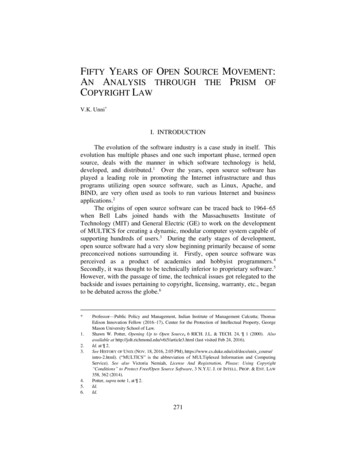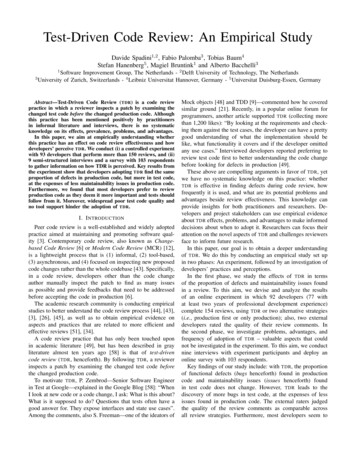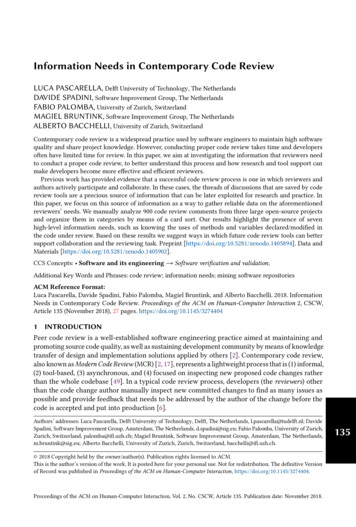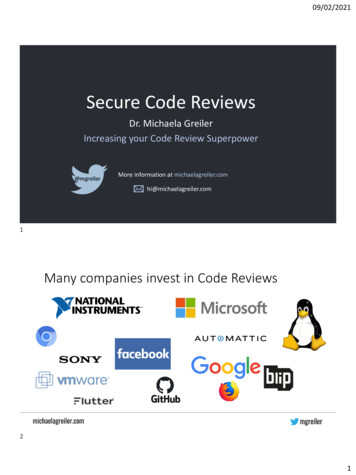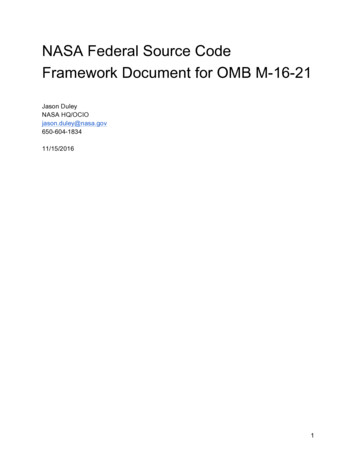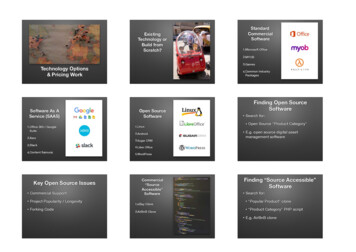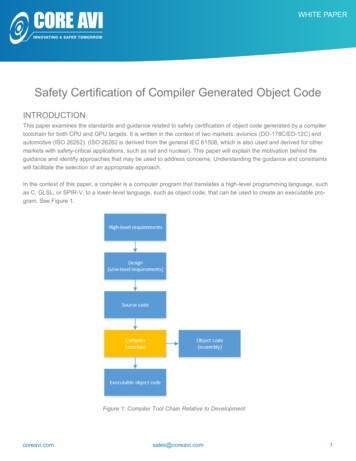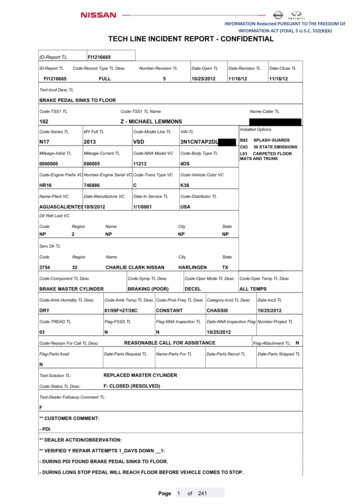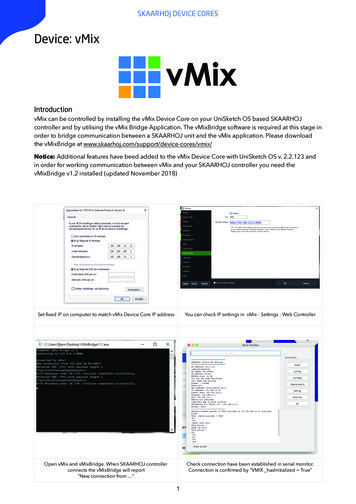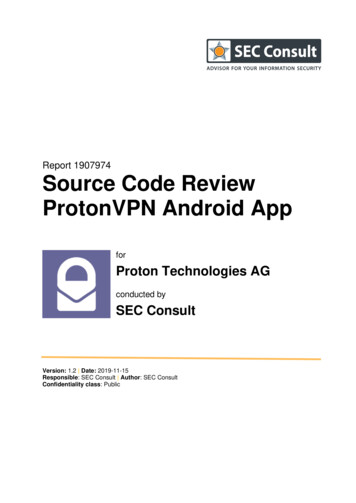
Transcription
Report 1907974Source Code ReviewProtonVPN Android AppforProton Technologies AGconducted bySEC ConsultVersion: 1.2 Date: 2019-11-15Responsible: SEC Consult Author: SEC ConsultConfidentiality class: Public
Report 1907974 for Proton Technologies AGSource Code Review – ProtonVPN Android AppResponsible:SEC ConsultVersion/Date:1.2 / 2019-11-15Confidentiality class:PublicTable of ContentsTable of Contents . 21 Management Summary . 31.1Scope and Timetable . 321.2Results . 41.3Disclaimer . 4Vulnerability Summary . 52.1Total Risk Per System . 52.234Risk of Each Vulnerability . 6Detailed Analysis . 73.1ProtonVPN Android App . 73.1.1General Information . 73.1.2Insecure Logout - FIXED . 73.1.3Debug Messages Enabled - ACCEPTED . 83.1.4Application Data Backup via ADB Enabled - FIXED . 93.1.5Hardcoded Credentials / Imperfect Data Encryption - ACCEPTED . 103.1.6Missing Certificate Pinning - FIXED . 11Version History . 12SEC Consultoffice@sec-consult.com www.sec-consult.comPage 2 of 12
Report 1907974 for Proton Technologies AGSource Code Review – ProtonVPN Android AppResponsible:SEC ConsultVersion/Date:1.2 / 2019-11-15Confidentiality class:Public1 Management SummaryThe following chapter summarizes the scope and timetable of the code review, the results of the codereview, and outlines the measures recommended by SEC Consult.1.1 Scope and TimetableDuring the initial security assessment for Proton Technologies AG, SEC Consult performed a source codereview of the ProtonVPN client for Android - a VPN app for Android devices, which offers private and securepassing of user traffic through Secure Core network in privacy-friendly countries like Switzerland andIceland. Objective of the review was to reveal security issues and to offer suggestions for improvement.The focus of the code review was to provide answers to the following questions:-Does the ProtonVPN solution ensure the privacy of the user?-Is an attacker able to access data of other customers (cross-tenant access)?-Is an attacker able to use paid ProtonVPN features without an account upgrade?The initial review was conducted in Q1 2019 and a total effort of 6 days was dedicated to identifying anddocumenting security issues in the code base of the ProtonVPN Android App.Version 2.0.4 of the application was tested. Full access to the source code was granted and test usercredentials of the roles “free”, “plus”, “professional”, and “visionary” were provided.The following files and documents were made available in the course of the review:FilesSHA1 dme.md368dbfbf2ed0e66426af14d5941ba45001ebfdf0In September 2019, Proton Technologies AG fixed the identified issues and supplied the fixes to SECConsult for verification. Goal of the fix verification was to confirm remediation provided by the applied fixes.SEC Consult verified the fixes in October 2019.SEC Consultoffice@sec-consult.com www.sec-consult.comPage 3 of 12
Report 1907974 for Proton Technologies AGSource Code Review – ProtonVPN Android AppResponsible:SEC ConsultVersion/Date:1.2 / 2019-11-15Confidentiality class:Public1.2 ResultsDuring the initial code review, SEC Consult found one medium-risk vulnerability and four low-riskvulnerabilities in the reviewed source code and the mobile app.Although issues with certificate validation have been identified within the encrypted communicationbetween the mobile application and the backend system, encrypted VPN traffic could not be decrypted.No issues were identified, which would provide an attacker unauthorized access to other customers’ datawithout having physical access to the victim’s device. An attacker with physical access to a mobile devicecan obtain user-related information from debug routines, as excessive debug messages contain varioususer-related information that can be easily accessed by an attacker.All security issues that were identified in the initial code review were properly fixed or acceptedby Proton Technologies AG.1.3 DisclaimerAt the request of Proton Technology AG, this report has been declassified from strictly confidential to public.While the report was shortened for public release, relevant vulnerability information has been maintained.In this particular project, a timebox approach was used to define the consulting effort. This means that SECConsult allotted a prearranged amount of time to identify and document vulnerabilities. Because of this,there is no guarantee that the project has discovered all possible vulnerabilities and risks.Furthermore, the security check is only an immediate evaluation of the situation at the time the check wasperformed. An evaluation of future security levels or possible future risks or vulnerabilities may not bederived from it.SEC Consultoffice@sec-consult.com www.sec-consult.comPage 4 of 12
Report 1907974 for Proton Technologies AGSource Code Review – ProtonVPN Android AppResponsible:SEC ConsultVersion/Date:1.2 / 2019-11-15Confidentiality class:Public2 Vulnerability SummaryThis chapter contains all identified vulnerabilities in the reviewed source code of the company ProtonTechnologies AG.Risk assessmentInitial no. ofvulnerability classesCurrent no. ofvulnerability classesLow40Medium10High00Critical00Total502.1 Total Risk Per SystemThe following table contains a risk assessment for each system which contained security flaws.SystemField of applicationInitial riskCurrent riskProtonVPN Android AppMobileMedium-Total-Medium-SEC Consultoffice@sec-consult.com www.sec-consult.comPage 5 of 12
Report 1907974 for Proton Technologies AGSource Code Review – ProtonVPN Android AppResponsible:SEC ConsultVersion/Date:1.2 / 2019-11-15Confidentiality class:Public2.2 Risk of Each VulnerabilityThe following table contains a risk assessment for the discovered vulnerabilities.VulnerabilitySystemInitial riskCurrent riskPageInsecure LogoutProtonVPN Android AppMediumFIXED7Debug Messages EnabledProtonVPN Android AppLowACCEPTED8Application Data Backupvia ADB EnabledProtonVPN Android AppLowFIXED9Hardcoded Credentials /Imperfect Data EncryptionProtonVPN Android AppLowACCEPTED10Missing Certificate PinningProtonVPN Android AppLowFIXED11Total-Medium--SEC Consultoffice@sec-consult.com www.sec-consult.comPage 6 of 12
Report 1907974 for Proton Technologies AGSource Code Review – ProtonVPN Android AppResponsible:SEC ConsultVersion/Date:1.2 / 2019-11-15Confidentiality class:Public3 Detailed AnalysisThis chapter outlines the attacks and found vulnerabilities in detail.3.1 ProtonVPN Android App3.1.1General InformationThis section describes vulnerabilities found in the ProtonVPN Android App.ProtonVPN Android App is designed for Android based mobile devices and provides VPN services to mobileusers. During the timeframe of the audit the ProtonVPN Android App version 2.0.4 was tested using arooted smartphone with Android OS 5.0. The tested Android application is written in Java, new functionsare implemented in Kotlin.3.1.2Insecure Logout - FIXEDThe ProtonVPN Android App does not perform a server-side logout after the mobile user clicks the logoutbutton inside the mobile app. After the logout, the app user is redirected to the app login screen, but nologout request is sent to the server, therefore it is possible to reuse session/authentication tokens after theuser logout.CVSS-v3 Base Score: 4.8 (Medium)CVSS-v3 Vector String: 1Recheck resultsDuring the fix verification it was not possible to reproduce the initial scenario. Upon logout, sessions werecorrectly terminated.SEC Consultoffice@sec-consult.com www.sec-consult.comPage 7 of 12
Report 1907974 for Proton Technologies AGSource Code Review – ProtonVPN Android AppResponsible:SEC ConsultVersion/Date:1.2 / 2019-11-15Confidentiality class:Public3.1.3Debug Messages Enabled - ACCEPTEDThe ProtonVPN Android App has debug messages enabled. It is a common practice to add debug routinesto the code while developing an application. Often developers forget to remove these debug functions anddeploy an application with enabled debugging features. During the audit timeframe it was identified thatdebug messages contain potentially sensitive data.CVSS-v3 Base Score: 2.9 (Low)CVSS-v3 Vector String: 1Recheck resultsThe following output is an excerpt of the debug messages produced by the mobile application. Variousinformation was observed in the log such as local internal IP address, local external IP address,OpenVPN/IKE2 username, detailed error stack traces:[ ]09-06 15:04:21.917request 4 [ AUTH ]73487690 I charon: 14[ENC] generating IKE AUTH09-06 15:04:21.918 7348 7690 I charon : 14[NET] sending packet: from192.168.0.159[46505] to 217.23.3.171[4500] (97 bytes)09-06 15:04:21.957 7348 7691 I charon : 15[NET] received packet: from217.23.3.171[4500] to 192.168.0.159[46505] (321 bytes)09-06 15:04:21.958 7348 7691 I charon : 15[ENC] parsed IKE AUTH response4 [ AUTH CPRP(ADDR DNS) SA TSi TSr N(AUTH LFT) N(MOBIKE SUP) N(ADD 4 ADDR)N(ADD 4 ADDR) N(ADD 4 ADDR) N(ADD 4 ADDR) N(ADD 4 ADDR) N(ADD 4 ADDR)N(ADD 4 ADDR) N(ADD 4 ADDR) ]09-06 15:04:21.958 7348 7691 I charonandroid' with EAP successful: 15[IKE] authentication of 'ikev2-09-06 15:04:21.959 7348 7691 I charon : 15[IKE] IKE SA android[1]established .23.3.171[ikev2-android]09-06 15:04:21.95935600s73487691 I charon: 15[IKE] scheduling rekeying in[ ]Statement Proton Technologies AG:All debug logs from within the Proton applications have been removed; the remaining output is generatedby loggers outside of the control of the app itself (e.g. system logs). Information that is shown there isclassified as low sensitivity. In the case of ProtonVPN applications, the VPN protocol credentials (forOpenVPN/IKEv2) are designed to be separate from a user’s account credentials and are also classifiedas low sensitivity.SEC Consultoffice@sec-consult.com www.sec-consult.comPage 8 of 12
Report 1907974 for Proton Technologies AGSource Code Review – ProtonVPN Android AppResponsible:SEC ConsultVersion/Date:1.2 / 2019-11-15Confidentiality class:Public3.1.4Application Data Backup via ADB Enabled - FIXEDThe ProtonVPN Android App uses the default settings, where it allows a user to perform application databackup. An attacker may be able to obtain backup data, which might contain sensitive information, via ADB.Although several conditions have to be met prior to a successful attack such as an attacker gains physicalaccess to the Android device where it has USB debugging enabled on it, these default settings are stillconsidered as a security issue that may cause high impact if the attacker can successfully exploit.CVSS-v3 Base Score: 2.1 (Low)CVSS-v3 Vector String: 1Recheck resultsDuring the recheck audit the android:allowBackup attribute under the application tag in theAndroidManifest.xml file was found to be set to “false” as shown in the following snippet:[ ] application android:theme "@style/AppTheme"android:label "@string/app name" android:icon "@mipmap/ic launcher"android:name llowBackup "false" android:largeHeap "true"android:supportsRtl "true"android:networkSecurityConfig "@xml/network security config"android:roundIcon "@mipmap/ic launcher round"android:appComponentFactory "androidx.core.app.CoreComponentFactory" uses-library android:name [ ]SEC Consultoffice@sec-consult.com www.sec-consult.comPage 9 of 12
Report 1907974 for Proton Technologies AGSource Code Review – ProtonVPN Android AppResponsible:SEC ConsultVersion/Date:1.2 / 2019-11-15Confidentiality class:Public3.1.5Hardcoded Credentials / Imperfect Data Encryption - ACCEPTEDThe Android app stores user settings locally in the Shared Preferences file. The contents of the file aresymmetrically encrypted using hardcoded keys together with the device identifier. Any attacker that hasphysical access to the device may obtain the encryption key from the decompiled app source code anddecrypt user settings.CVSS-v3 Base Score: 2.9 (Low)CVSS-v3 Vector String: 1Recheck resultsThe issue remained unchanged. However, the risk is accepted by Proton Technologies AG.Statement Proton Technologies AG:These credentials are used to allow a client to send based exception reports (one way) to a loggingsystem; additionally, the API endpoint for reporting is rare limited.SEC Consultoffice@sec-consult.com www.sec-consult.comPage 10 of 12
Report 1907974 for Proton Technologies AGSource Code Review – ProtonVPN Android AppResponsible:SEC ConsultVersion/Date:1.2 / 2019-11-15Confidentiality class:Public3.1.6Missing Certificate Pinning - FIXEDCertificate Pinning allows mobile applications to verify that they are only connecting to a server overSSL/TLS which he is intended to. Furthermore, it is possible to verify, that the connection between clientand server is end-to-end encrypted and not intercepted. This is ensured by embedding a hash of theserver’s certificate or a hash of the public key directly into the application.During the process of establishing a connection to the server, the hash of the certificate/public key of theserver is obtained and compared against the embedded hash of the certificate(s)/public key(s). If theretrieved hash of the certificate/public key is matching the locally stored hash of the certificate/public keythe connection will be established, otherwise the connection will fail.CVSS-v3 Base Score: 3.7 (Low)CVSS-v3 Vector String: 1Recheck resultsDuring the security assessment it was not possible for an attacker to intercept and manipulate thecommunication between the mobile app and the backend server:Figure 1. Certificate pinning is in place.SEC Consultoffice@sec-consult.com www.sec-consult.comPage 11 of 12
Report 1907974 for Proton Technologies AGSource Code Review – ProtonVPN Android AppResponsible:SEC ConsultVersion/Date:1.2 / 2019-11-15Confidentiality class:Public4 Version HistoryVersionDateStatus/ChangesCreated byResponsible1.02019-03-15Initial reportSEC ConsultSEC Consult1.12019-10-10Fix verificationSEC ConsultSEC Consult1.22019-11-15Public reportSEC ConsultSEC ConsultSEC Consultoffice@sec-consult.com www.sec-consult.comPage 12 of 12
Source Code Review - ProtonVPN Android App Responsible: SEC Consult Version/Date: 1.2 / 2019-11-15 Confidentiality class: Public SEC Consult office@sec-consult.com www.sec-consult.com Page 7 of 12 3 Detailed Analysis This chapter outlines the attacks and found vulnerabilities in detail. 3.1 ProtonVPN Android App 3.1.1 General Information
